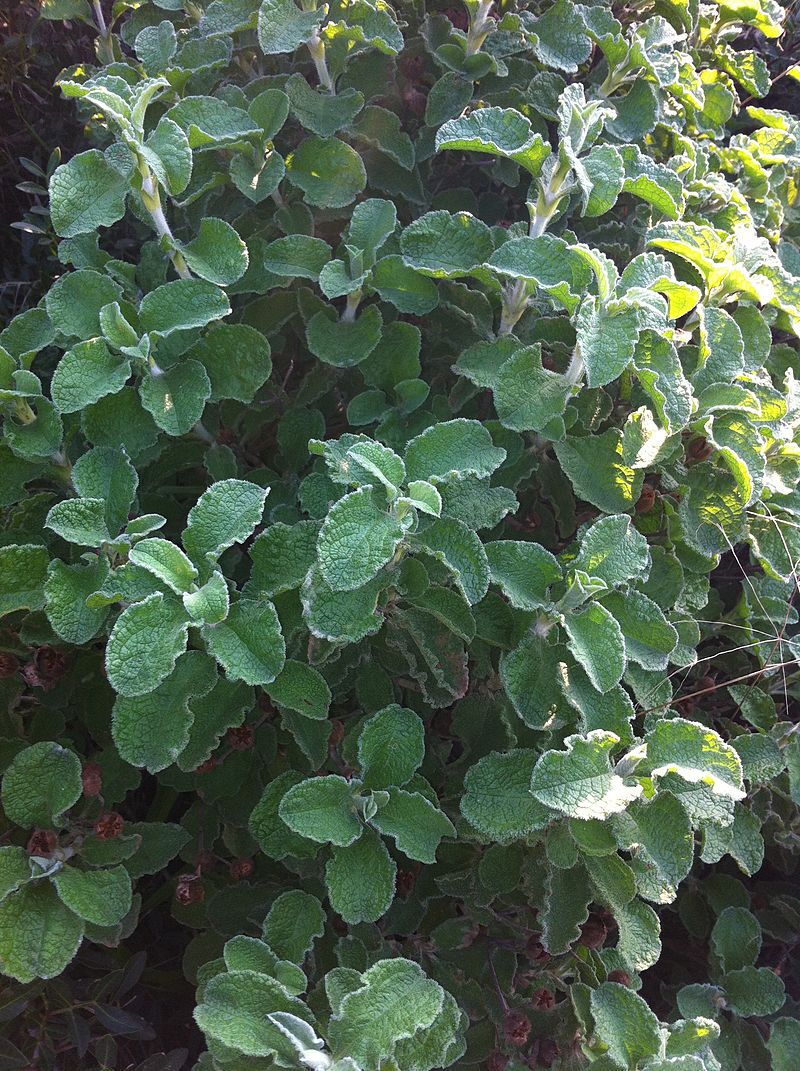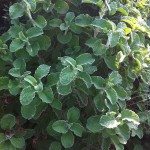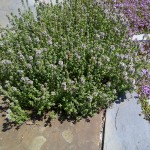Za’atar is an herb blend commonly used in Middle Eastern cooking. The basic formula is composed of marjoram, oregano, thyme, toasted sesame seeds and salt. Different countries have their own additions to the basic formula that is unique to their culture.
Marjoram – Ideally you should use Za’atar marjoram (Origanum syriacum) in your blend. Its flavor is a combination of thyme and oregano and is the authentic marjoram for this mixture. It grows to a height of 3 feet and is hardy only to zone 8. If you don’t have Za’atar marjoram growing in your herb garden or can’t find it in your area, you can substitute sweet marjoram (Origanum majorana). Sweet marjoram is a smaller plant reaching a height of 2 feet but it is hardy through zone 7.
 Oregano – sometimes called “wild marjoram”, most people have Origanum vulgare in their gardens, a tall 2’ high. It has a rather bland flavor so I always recommend Greek oregano (Origanum vulgare spp hirtum) which has a stronger flavor and is a better culinary choice. Greek oregano is shorter only reaching 1’. Both are hardy through zone 5.
Oregano – sometimes called “wild marjoram”, most people have Origanum vulgare in their gardens, a tall 2’ high. It has a rather bland flavor so I always recommend Greek oregano (Origanum vulgare spp hirtum) which has a stronger flavor and is a better culinary choice. Greek oregano is shorter only reaching 1’. Both are hardy through zone 5.
Thyme – (Thymus vulgaris) It’s the upright thymes, small 8” bushes, that you want to use for cooking. There are so many different kinds that it can be hard to choose. For Za’atar, stick with English, French or common thymes. I recommend the common thyme. It has a stronger flavor and is commonly found around the Mediterranean. All of the upright thymes are hardy through zone 5.
How to Grow
All three of these herbs are grown the same. They need full sun, although thymes can tolerate a little shade, and well-drained soil. They like to be drier. All of these herbs can easily be grown in containers. Go easy on the fertilizer. They like poor soils. Compost is always the best thing to use on your herbs.
Harvest
Once they have reached their full size, you can harvest up to 75% of each plant at once. Harvesting is best done early in the morning after the dew has dried. Herbs are at their flavor peak at that time of day. Because all three of these herbs are perennials, you should stop harvesting from them about a month before your first frost. Harvesting, like pruning, stimulates growth. You want that new growth to have time to harden off before winter or it will die.
Drying
Za’atar is made with dried herbs. You have many choices of drying methods. You can use the classic drying in bunches, upside down, or in a single layer on a screen. In both cases, you want to dry in a dark, well-ventilated area. You can dry herbs in your oven. Spread them in a single layer on a cookie sheet and bake them in a 110°F oven for 2 to 3 hours. Be careful not to leave them in the oven too long or they may burn. Herbs can also be dried in a microwave on high for 1 to 2 minutes.
Food dehydrators are another popular way to dry herbs. Follow the directions for your unit for best results. If you have trouble with tiny leaves falling through the shelves, use a few layers of cheesecloths to line the shelves.
Making your blend
Once your herbs are dried, you want to grind the dried leaves. The best method is with a mortar and pestle. Using the back of a spoon on a hard surface will also work. Combine your ground herbs with toasted sesame seeds and salt, then add any spices, according to the regional cuisine you will be preparing.
Leftover za’atar should be stored like your dried herbs in tightly sealed glass jars in a cool, dark space. Heat or sunlight will degrade the flavors of your herbs.
More Herb Blends
Bouquet Garni
Curry Blend
Chinese Five Spice Blend
Fines Herbes
Herbes de Provence
Italian Seasoning
Old Bay Seasoning
Paprika
Poultry Seasoning




2 Comments on “Grow Your Own Za’atar”
I also grow and make my own mixes as well.
I like how you added to store your mixes in glass jars. One time I stored it in a plastic bin and all of the Zaatar mix, after a while, tasted and smelled like plastic some what.
People told me that I cannot grow these type of herbs in the United States. So I decide to grow every type of herb that is named or referred to as Zaatar, from around the world.
Thank you for your post
Hi! So interesting! There is also Zaatar (Origanum Syriacum) I found on Mountain Rose Herbs, from Strictly Medicinal Seeds in Oregon. Another video called Zaatar Bible Hyssop. I’m excited to try it, wonder if it tastes like this blend!